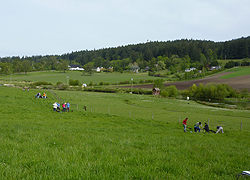
Gleysols occur in poorly drained areas such as seasonally wet meadows
Gleysols (or Aquic suborders of most orders in USDA Soil Taxonomy) are soils that have undergone prolonged periods of intermittent or continuous saturation with water causing reducing conditions during their genesis. This results in characteristic colours and mottling. Water saturation leads to depletion of oxygen in the soil and cause the transformation of metals such as iron. When oxygen is present, iron is oxidized and has a reddish colour, while when oxygen becomes depleted (due to water saturation) the iron is reduced and takes on a blue-grey hue and this dominates the colour of the horizon. The diagnostic criteria for Gleysolic soils in the presence of well-developed gley features within 50 cm of the soil surface. Horizons with these features are labelled with the subscript g (e.g., Bg, Aeg, Cg).
The three great groups of the Gleysolic order are distinguished based on the presence of a B horizon enriched in clay (Btg horizon), an Ah horizon, or an absence of both of these features.
Luvic Gleysolic Great Group
Soils of this great group have a Btg horizon and often have an eluvial Aeg horizon overlying the clay-enriched horizon.
Humic Gleysolic Great Group
These soils have an organically enriched A horizon (Ah) thicker than 10 cm (or a Ap horizon thicker than 15 cm) and have a least 3.5% organic matter in the surface horizon.
Gleysolic Great Group
These soils lack either a Btg or an Ah horizon. In some cases these soils develop in pond sediments created by the organisms that live in the wetlands (biogenic sediments).